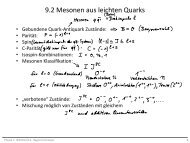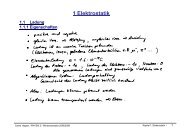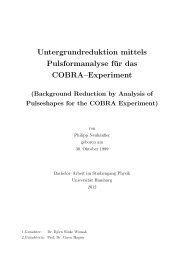Setup of a Drift Tube Muon Tracker and Calibration of Muon ...
Setup of a Drift Tube Muon Tracker and Calibration of Muon ...
Setup of a Drift Tube Muon Tracker and Calibration of Muon ...
You also want an ePaper? Increase the reach of your titles
YUMPU automatically turns print PDFs into web optimized ePapers that Google loves.
eeSurvival probability for ν e, P0.80.70.60.50.4P ee for LMA7Be: Borexino8B: Borexino, (> 3 MeV)8B: Borexino (> 5 MeV)8B: SNO (> 4 MeV)pp: all solar ν experiments0.30.2-110 1 10E ν[MeV]Figure 4.10: Survival probability P ee for different neutrino energies as measured byseveral solar neutrino experiments. The pink line shows the expected survival probabilityfrom the MSW-LMA predictions. The data points cover, very interestingly,the transition area between matter dominated <strong>and</strong> vacuum dominated neutrino oscillations.Figure from [75].Very conveniently, there are no near-by nuclear reactors to the LNGS undergroundlaboratory. The mean baseline to distant nuclear reactors is approximately 1000 km.Nevertheless, the contribution <strong>of</strong> reactor neutrinos is not negligible. The main contributioncomes from 194 reactors in Europe, whereas the remaining 245 reactorsaround the world contribute only 2.5% <strong>of</strong> the nuclear ¯ν e flux at Gran Sasso. Theexpected neutrino signal from nearby reactors has been carefully investigated by adetailed analysis <strong>of</strong> their power time pr<strong>of</strong>iles <strong>and</strong> nuclear fuel composition.No significant flux <strong>of</strong> geo-neutrinos with an energy above 3.272 MeV is expected(cf. Section 2.4.4). This corresponds to a visible energy <strong>of</strong> approximately 2.6 MeV or1300 p.e. in Borexino. Reactor neutrinos, however, can easily reach energies up to8MeV. In the geo-neutrino window, 5.0±0.3 events from reactors are expected. Sincethe neutrinos in the energy regime leading to a light yield above 1300 p.e. originatesolely from nuclear reactors, this region can be used to confirm the assumptions madefor the reactor neutrino flux. The collected data is presented in Fig. 4.11. A fit hasbeen done for the contributions <strong>of</strong> geo-neutrinos, reactor neutrinos <strong>and</strong> backgroundto the spectrum. The best estimates are N geo = 9.9 +4.1−3.4 <strong>and</strong> N react = 10.7 +4.3−3.4 at68.3 %C.L., the hypothesis <strong>of</strong> no geo-neutrinos being observed is rejected at 99.997 ˙%C.L. The measurement also rejects the hypothesis <strong>of</strong> an active geo-reactor in theEarth’s core with a power above 3 TW at 95 %C.L.4.5 pep <strong>and</strong> CNO NeutrinosThe results from the Borexino 7 Be <strong>and</strong> 8 B neutrino measurements combined withother solar neutrino experiments show that the LMA-MSW oscillation predictionsare in good agreement with the observations. However, the energy region between66





